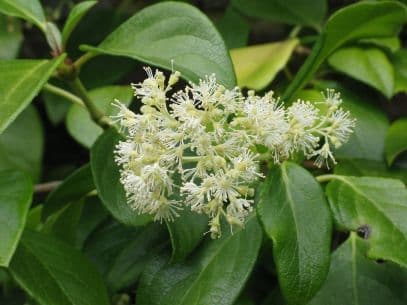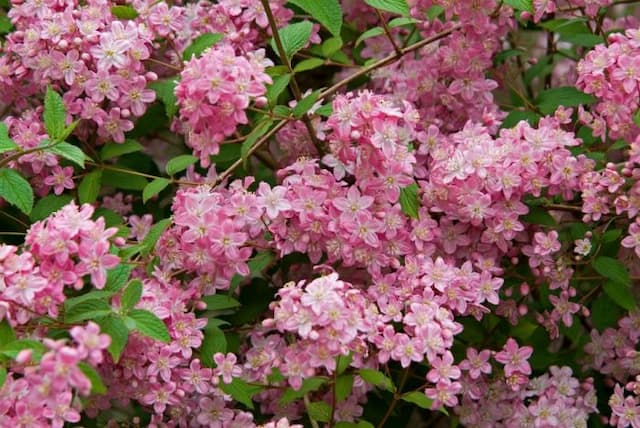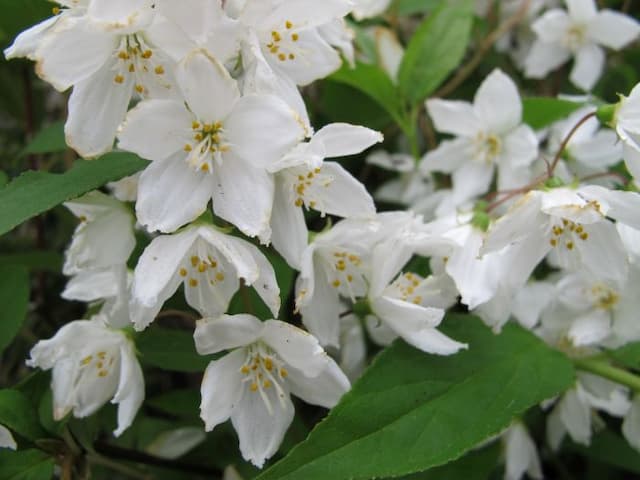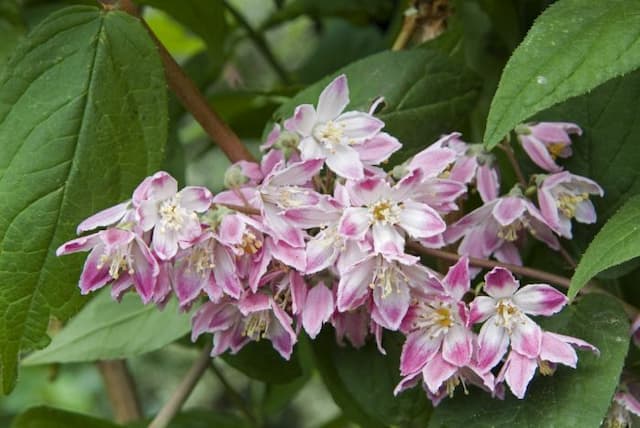Hydrangea Hydrangea macrophylla Magical Colourdream = 'Hortmacodre' (PBR) (Magical Series) (H)

ABOUT
The Hydrangea macrophylla Magical Colourdream, part of the Magical Series and commonly known simply as hydrangea, is a visually striking plant renowned for its large and colorful flower heads. The blossoms typically exhibit a range of colors as they mature, including shades of pink, blue, and purple, with the exact hue influenced by the acidity of the soil. The flowers appear lush and rounded, forming globe-like clusters that are both dense and showy. The plant's leaves are broad, with a deep green color, creating a lush backdrop for the vivid blooms. The texture of the leaves tends to be smooth with a somewhat glossy finish, providing a year-round visual interest even when the plant isn't in full bloom. The stems are sturdy, supporting the weight of the heavy blooms and keeping them prominently displayed. This variety of hydrangea often reblooms, providing an extended season of color. Overall, the Hydrangea macrophylla Magical Colourdream is prized for its ornamental value, with its stunning, morphing blooms being a centerpiece in many gardens. The visual impact of the plant is magnified when grouped, creating a sea of color and texture that appeals to many gardeners and flower enthusiasts.
About this plant
 Names
NamesFamily
Hydrangeaceae
Synonyms
Bigleaf Hydrangea, French Hydrangea, Lacecap Hydrangea, Mophead Hydrangea, Hortensia
Common names
Hydrangea macrophylla 'Hortmacodre'
 Toxicity
ToxicityTo humans
Hydrangeas, including the Hydrangea macrophylla, are considered to have a mild level of toxicity if ingested. While they are not typically deadly, eating parts of the hydrangea plant can lead to gastrointestinal upset, with symptoms such as nausea, vomiting, and diarrhea. In some rare cases, more serious symptoms such as depression, lethargy, or confusion could occur. Always exercise caution and keep the plant out of reach of children to prevent accidental ingestion.
To pets
Hydrangeas are also toxic to pets; they contain compounds called cyanogenic glycosides, which can release cyanide when chewed or digested. If a pet ingests hydrangea leaves, buds, or flowers, it might experience symptoms such as vomiting, diarrhea, lethargy, and depression. In severe cases, ingestion could lead to more serious symptoms like difficulty breathing or increased heart rate. If you suspect your pet has eaten any part of a hydrangea plant, it is important to seek veterinary care immediately.
 Characteristics
CharacteristicsLife cycle
Perennials
Foliage type
Deciduous
Color of leaves
Green
Flower color
Varies
Height
3-5 feet (0.91-1.52 meters)
Spread
3-5 feet (0.91-1.52 meters)
Plant type
Shrub
Hardiness zones
5-9
Native area
Asia
Benefits
 General Benefits
General Benefits- Attractive Blooms - Produces large, colorful flowers that can change shades as they age, adding visual appeal to gardens and landscapes.
- Long Flowering Period - Blooms from early summer to late fall, providing a long duration of ornamental interest.
- Versatility - Suitable for planting in garden beds, borders, and as a specimen plant, offering diverse landscaping options.
- Seasonal Interest - Flowers aside, the plant can also have attractive foliage in the fall, offering seasonal variety to a garden setting.
- Low Maintenance - Generally requires minimal care beyond regular watering and occasional pruning, making it ideal for a variety of gardeners.
- Pest Resistance - Often resistant to common garden pests, leading to fewer concerns with pest management.
- Durability - Demonstrates resilience in various soil conditions and can tolerate some degree of urban pollution.
- Cold Hardy - Capable of surviving in cooler climates and can withstand frost, given appropriate care and siting.
- Can Be Propagated - Gardeners can propagate from cuttings, allowing for the expansion of their garden without additional cost.
 Medical Properties
Medical PropertiesThis plant is not used for medical purposes.
 Air-purifying Qualities
Air-purifying QualitiesThis plant is not specifically known for air purifying qualities.
 Other Uses
Other Uses- Photography Backdrop: Hydrangeas, with their large, colorful blooms, can act as a stunning backdrop for portrait and macro photography, adding natural beauty to the composition.
- Craft Projects: Dried hydrangea flowers can be used in crafting, such as creating floral wreaths or embellishing greeting cards and picture frames.
- Wedding Decor: Hydrangeas are popular choices for wedding decorations, from table centerpieces to bridal bouquets, for their full, lush appearance and variety of colors.
- Color-changing Experiment: By altering the soil pH, gardeners can change the color of hydrangea blooms, providing an educational experience in soil chemistry and plant physiology.
- Fabric Dyeing: The blooms of hydrangeas can be used to naturally dye fabrics, yielding various shades depending on the mordant and the color of the flowers used.
- Culinary Garnish: Although not widely recognized for culinary uses, hydrangea blooms can be used as a decorative, non-toxic garnish for special dishes, as long as they are pesticide-free.
- Visual Screening: Due to their bushy growth habit, hydrangeas can be planted to provide a visual screen or natural fencing in gardens and yards.
- Education & Research: Hydrangeas can be used as a subject in botanical studies due to their distinct macrophylla characteristics and response to environmental changes.
- Art Inspiration: The varied and vibrant colors of hydrangea blooms inspire artists for paintings, illustrations, and textile patterns.
- Relaxation Spaces: As part of a mindfulness or meditation garden, hydrangeas contribute to a serene ambiance with their soft, large blossoms and rich foliage.
Interesting Facts
 Feng Shui
Feng ShuiThe Hydrangea is not used in Feng Shui practice.
 Zodiac Sign Compitability
Zodiac Sign CompitabilityThe Hydrangea is not used in astrology practice.
 Plant Symbolism
Plant Symbolism- Heartfelt Emotions: Hydrangeas are often associated with the expression of genuine, heartfelt emotions, due to their lush and abundant flower heads.
- Gratitude: The hydrangea is a symbol of thankfulness and appreciation, often given as a gift to express gratitude.
- Vanity: In some cultures, hydrangeas represent vanity and boastfulness, possibly because of their showy appearance.
- Perseverance: The hydrangea can symbolize perseverance, as it is a plant that can bloom and thrive even under harsh conditions.
- Abundance: With its full, round clusters of flowers, hydrangeas are often seen as a symbol of abundance and prosperity.
 Water
WaterHydrangeas, including the Hydrangea macrophylla or Bigleaf Hydrangea, should be watered deeply, ensuring the soil around the root zone is moist but not soggy. During the growing season, watering may be necessary once or twice a week, depending on climate and soil conditions. Aim for about 1 gallon of water per plant during each watering session in normal conditions. In the hotter months, you might need to water more frequently to keep the soil moist, but avoid waterlogging the plant. Reduce watering in the fall and further in winter when the plant is dormant.
 Light
LightBigleaf Hydrangeas prefer dappled sun or partial shade, thriving best when shielded from the intense afternoon sun. Morning sunlight with afternoon shade or filtered light throughout the day is ideal to prevent scorching their leaves. They can be situated under a tall tree that provides filtered sunlight or on the north or east side of a building where they receive soft, ambient light.
 Temperature
TemperatureBigleaf Hydrangeas grow well in a wide range of temperatures but prefer a range of 65°F to 75°F for optimal growth. They can survive minimal temperatures around 50°F but are not frost-tolerant and can be damaged by temperatures below freezing. The maximum temperature tolerated is around 80°F to 85°F before the plant may show signs of heat stress.
 Pruning
PruningPrune Bigleaf Hydrangeas to maintain shape and remove dead or old wood, which encourages new growth and more blooms. The best time for pruning is after they have finished flowering in late summer, as they bloom on old wood. Cut back the flowering stems to a pair of healthy buds. Annually remove any weak or dead stems to keep the plant healthy.
 Cleaning
CleaningAs needed
 Soil
SoilFor the Bigleaf Hydrangea, the best soil mix is well-draining, rich in organic matter, with a pH of 5.2-5.5 for blue flowers and pH 6.0-6.2 for pink flowers.
 Repotting
RepottingBigleaf Hydrangeas should be repotted every 2-3 years, or when the plant becomes root-bound to maintain healthy growth.
 Humidity & Misting
Humidity & MistingBigleaf Hydrangeas thrive in conditions with high humidity levels, between 60-70%.
 Suitable locations
Suitable locationsIndoor
Place in bright, indirect light and keep soil moist.
Outdoor
Plant in morning sun, afternoon shade; keep soil moist.
Hardiness zone
5-9 USDA
 Life cycle
Life cycleHydrangea macrophylla, commonly known as bigleaf hydrangea, begins its life cycle when a seed germinates in moist, fertile soil during the spring. The seedling emerges and develops into a juvenile plant with lush, green foliage and begins to establish a robust root system. As the plant matures, it enters a vegetative stage where it grows steadily, becoming a bushy shrub with large leaves; this stage can last several years before the plant reaches maturity. Upon reaching reproductive maturity, the bigleaf hydrangea produces large, colorful flower heads, usually in early to mid-summer, which can be blue, pink, or purple depending on soil pH. After pollination, the flowers will gradually fade and seed production will occur, followed by a period of dormancy in the fall and winter where the plant's above-ground parts die back as it conserves energy for the next growing season. Each spring ushers in a new growth cycle as the hydrangea awakens from dormancy and the process repeats.
 Propogation
PropogationPropogation time
Spring to Early Summer
Hydrangea macrophylla, commonly known as bigleaf hydrangea, is most popularly propagated through softwood cuttings. This method is usually carried out in late spring or early summer when the plant's new growth is still tender and flexible, but well enough established to sustain a cutting. To propagate, a grower would cut a section of stem about 5 to 6 inches (approximately 13 to 15 centimeters) long, ensuring that it includes several leaf nodes. The lower leaves are removed, and the cut end is often dipped in a rooting hormone to enhance root development. The cutting is then planted in a well-draining soil mix, and the environment is kept humid to encourage rooting, usually by covering the cutting with a plastic bag or placing it in a propagation chamber. Roots typically form within a few weeks to a couple of months, after which the new hydrangea plant can be transferred to a more permanent location.






![Rose deutzia [Yuki Cherry Blossom]](/_next/image?url=https%3A%2F%2Fplants-admin.emdemapps.com%2Fimages%2Fplants%2F%2Fimages%2F604b6510a383a.png&w=640&q=75)


![Hydrangea [Hot Chocolate]](/_next/image?url=https%3A%2F%2Fplants-admin.emdemapps.com%2Fimages%2Fplants%2F%2Fimages%2F604b5a066e3bd.png&w=640&q=75)